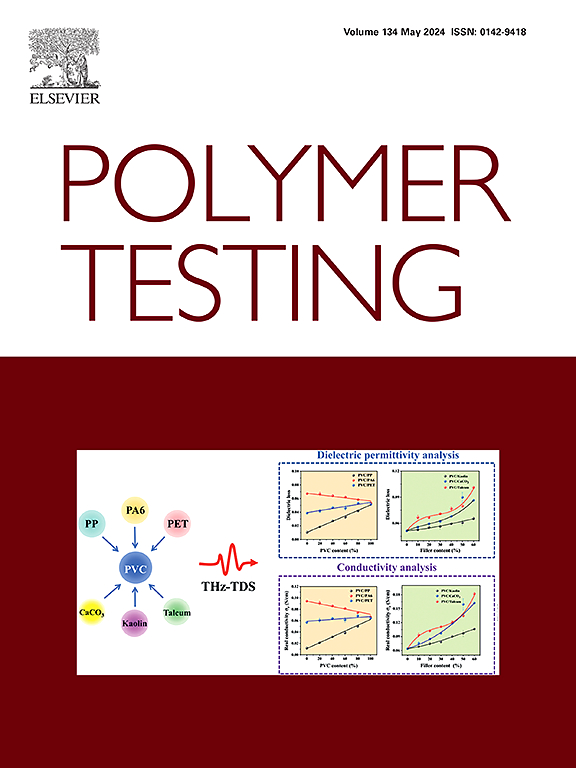Optimal mix ratio and numerical simulation study of concrete modified by nano-silica synergistically reinforced with basalt fibers
IF 6
2区 材料科学
Q1 MATERIALS SCIENCE, CHARACTERIZATION & TESTING
引用次数: 0
Abstract
With the implementation of a series of national strategies, China's infrastructure construction is facing significant opportunities as well as considerable challenges. As one of the core building materials, concrete is required to meet increasingly stringent performance demands. Against this backdrop, this study focuses on developing a high-performance concrete with both high strength and high toughness. Basalt fiber (BF) and nano-silica (NS) were selected as the primary modifying materials. An orthogonal experimental design was employed to systematically investigate the effects of BF length, BF content, and NS content on the strength and toughness of concrete, in order to determine the optimal mix proportion. Experimental results show that as BF length, BF content, and NS content increase, both strength and toughness indicators initially increase and then decrease. The influence of each factor on performance indicators follows the order: BF content > BF length > NS content. Based on range analysis and variance analysis of the orthogonal tests, the optimal mix proportion was determined as BF length: BF content: NS content = 6 mm: 0.2 %: 2 %. Mechanical tests and microstructural observations were conducted on specimens prepared with the optimal mix. The results indicate that NS effectively fills micro-pores within the concrete, enhances density, and significantly improves mechanical performance. The coral-like micro/nano structures formed by NS modification significantly increase the surface roughness of BF. These structures highlight the excellent synergistic interaction between BF and NS, which jointly enhance the interfacial bonding performance. BF also provides a bridging effect within the concrete matrix, inhibits microcrack propagation, and markedly enhances toughness. Furthermore, numerical simulations were used to further elucidate the fracture behavior and energy evolution of flexural test specimens. The simulation results for peak stress, ultimate strain, and failure modes showed good agreement with experimental findings. The stress contour maps of nano-silica and basalt fiber-modified concrete (BFNSRC) and Part-BF were consistent with theoretical expectations. Energy–crack evolution analysis revealed that the cement matrix primarily absorbs and dissipates energy, while the presence of BF contributes additional dissipative capacity, thereby enhancing the material's toughness. The results of this study provide technical support and theoretical guidance for the preparation of high-strength, high-toughness, high-performance concrete.
玄武岩纤维协同增强纳米二氧化硅改性混凝土的最佳配合比及数值模拟研究
随着一系列国家战略的实施,中国的基础设施建设既面临重大机遇,也面临严峻挑战。混凝土作为核心建筑材料之一,对其性能要求越来越高。在此背景下,本研究的重点是开发高强度和高韧性的高性能混凝土。以玄武岩纤维(BF)和纳米二氧化硅(NS)为主要改性材料。采用正交试验设计,系统研究了BF长度、BF掺量、NS掺量对混凝土强度和韧性的影响,以确定最佳配合比。试验结果表明,随着BF长度、BF含量和NS含量的增加,强度和韧性指标均呈现先增大后减小的趋势。各因素对性能指标的影响顺序为:BF含量>;高炉长度>;NS的内容。通过正交试验的极差分析和方差分析,确定了最佳配合比为:BF长度:BF含量:NS含量= 6 mm: 0.2%: 2%。采用最佳配合比对制备的试样进行了力学试验和显微组织观察。结果表明,NS能有效填充混凝土内部微孔,提高密实度,显著改善混凝土力学性能。NS改性后形成的类珊瑚微纳结构显著提高了高炉表面粗糙度。这些结构突出了BF和NS之间良好的协同作用,共同提高了界面粘合性能。BF还在混凝土基体内提供桥接效应,抑制微裂纹扩展,并显著提高韧性。通过数值模拟进一步阐明了试件的断裂行为和能量演化规律。峰值应力、极限应变和破坏模式的模拟结果与实验结果吻合较好。纳米二氧化硅和玄武岩纤维改性混凝土(BFNSRC)和部分bf的应力等值线图与理论预期一致。能量-裂纹演化分析表明,水泥基体主要吸收和耗散能量,而高炉的存在增加了耗散能力,从而提高了材料的韧性。研究结果为高强度、高韧性、高性能混凝土的制备提供了技术支持和理论指导。
本文章由计算机程序翻译,如有差异,请以英文原文为准。
求助全文
约1分钟内获得全文
求助全文
来源期刊

Polymer Testing
工程技术-材料科学:表征与测试
CiteScore
10.70
自引率
5.90%
发文量
328
审稿时长
44 days
期刊介绍:
Polymer Testing focuses on the testing, analysis and characterization of polymer materials, including both synthetic and natural or biobased polymers. Novel testing methods and the testing of novel polymeric materials in bulk, solution and dispersion is covered. In addition, we welcome the submission of the testing of polymeric materials for a wide range of applications and industrial products as well as nanoscale characterization.
The scope includes but is not limited to the following main topics:
Novel testing methods and Chemical analysis
• mechanical, thermal, electrical, chemical, imaging, spectroscopy, scattering and rheology
Physical properties and behaviour of novel polymer systems
• nanoscale properties, morphology, transport properties
Degradation and recycling of polymeric materials when combined with novel testing or characterization methods
• degradation, biodegradation, ageing and fire retardancy
Modelling and Simulation work will be only considered when it is linked to new or previously published experimental results.
 求助内容:
求助内容: 应助结果提醒方式:
应助结果提醒方式:


